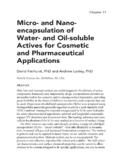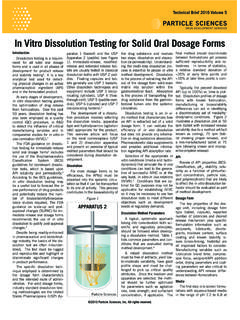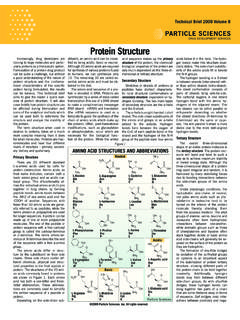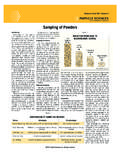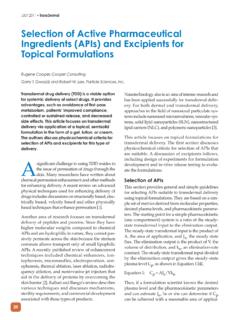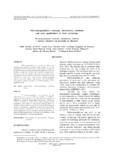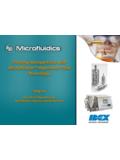Transcription of Encapsulation - particlesciences.com
1 2010 Particle Sciences, Inc. All rights from a vibrating nozzle yields particles with a very narrow size ProcessesFor water-insoluble APIs, the API/excipient/solvent solution can be emulsified into an aqueous surfactant solution using industry-standard emulsification equipment such as overhead paddle mixers, rotor-stator homogenizers and in-line static mixers. Precise control of droplet size can be achieved with emulsification techniques such as tangential-flow membrane (TFM) emulsification2, microfluid-ics and vibrating nozzles. Emul-sions are made by TFM by for- cing the organic phase through the pores of a membrane separating it from a tangentially flowing aque-ous emulsifier phase. Flow-rates and pore size, shape, angle, and surface-chemistry control the drop-let size and distribution.
2 Vibrating nozzles and microfluidic devices EncapsulationIntroductionActive pharmaceutical ingredi-ents (APIs) are often administered as aqueous solutions or suspen-sions, and pharmacokinetics are primarily determined by drug concentration or particle size, re-spectively. Sometimes additional functionality is required of a for-mulation, such as taste-masking, physicochemical protection of fragile APIs, and extended API re-lease. API-loaded micro and nano-particles may achieve these goals. Excipients used to prepare such particles include polymers (usually polyesters such as poly (L-lactic-co-glycolic acid, polycaprolactone, etc), lipids (phospholipids, trigly- cerides and natural waxes) or insol-uble metal salts and oxides (such as silica, calcium phosphate and calcium carbonate).)
3 This technical brief will focus on ways to prepare and characterize drug-loaded mi-crocapsules in the micron to milli-meter size range with two types of morphology; matrix-type in which the API is distributed homoge-neously throughout the microcap-sule, and core-shell in which the particle has a layered structure with API contained in the core (see Figure 1). Various processes, and the properties of the capsules they yield, are in Table 1. Matrix MicrocapsulesSolvent Cast/GrindA simple way to prepare API-loaded matrix microcapsules is to dissolve the API and the particle-forming excipient in a solvent, remove the solvent to produce a slab of drug-loaded excipient, then grind the slab to produce a powder of drug-loaded particles.
4 The volatile organic solvents must be removed from the final product to acceptably safe levels. In the case of lipidic excipients, casting the slab from a mixture of API and molten excipient avoids the use of solvents. If the API is soluble in the excipient, then homogeneous particles result from grinding the slab, otherwise inhomogeneous distribution can result. This may be minimized by first micronizing the API to a size much smaller than the final desired ProcessesAn alternative method to make particles from a solution of API and excipient it is spray drying; the API/excipient/solvent solution is atomized through a heated nozzle into a chamber where the solvent evaporates from the droplets to yield solid particles1 (see Figure 2).
5 The solvent is recovered for disposal or recycling, and the par-ticles are collected in a cyclone. Particles are usually approximately spherical, and in the size range of 1 50 m. For matrix excipients that melt at relatively low tempera-tures (such as waxes and lipids), solvent-free spray-chilling can be used here the API and excipi-ents are co-melted, and sprayed in molten form through the nozzle and the particles harden on cool-ing. Spraying under laminar flow Technical Brief 2010 Volume 71 m - 5 mm1 m - 100 m1 m - 100 m10 m - 5 mm100 nm 5 mm100 nm 5 mm100 m 5 mm100 nm 5 mm1 m - 5 mm100 nm - 500 m100 nm - 5 mm1 mm - 5 mmmatrixX XXXXXX XXcore-shell X XXXXXXENCAPSULATION METHODS AND THE TYPICAL PROPERTIES OF CAPSULES PRODUCEDT able 1 Solvent cast/grindSpray chillingSpray dryingVibrating-nozzle (narrow size distribution)Emulsification/solvent evaporationMelt/emulsify/chill (forms solid lipid particles)Spray-coating/pan coatingPolymer phase separation from solutionCoacervationInterfacial polymerizationSuspension polymerizationExtrusion/spheronization (extrusion/micropelletization)
6 ProcessMorphologyApproximate Size Range Particle Sciences CROSS-SECTIONS OF TWO TYPES OF MICROCAPSULES Figure 1 MatrixCore-Shellcan also form particles with a very narrow size distribution. In all emulsion-based processes, the organic solvent must be relatively insoluble in water, and preferably have a low boiling point for easy removal. Methylene chloride is of-ten the solvent of choice, though ethyl acetate is also used since it can be readily removed by dilution due to its higher water solubility (~8%), and has lower toxicity than chlorinated solvents. If low melt-ing-point particle-forming excipi-ents are used, the molten excipi-ent/API phase can be emulsified and the solid-lipid microcapsules form on cooling without the use of organic a related process, alginate-based microcapsules can be made without the use of any organic solvents.
7 An aqueous solution of sodium alginate containing API is dripped into a solution of Ca2+ ions. The divalent metal ions cause the dissolved alginate poly-mer to gel and form particles. This process has even been used to en-capsulate live cells and bacteria3. Hot-Melt Extrusion (HME)API and thermoplastic ex-cipients can be intimately mixed without solvent under high shear and elevated temperature using co-rotating intermeshing screws of a hot-melt extruder. The extruded ribbon can be micropelletized, ground, or spheronized to produce final API-loaded particles. API/mi-crocrystalline cellulose micropar-ticles are made this way for filling into gelatin matrix particles contain API homogeneously distributed throughout the particle, material at the surface can be released too quickly, be degraded or impart un-pleasant taste, and release is not constant over time.
8 Core-shell par-ticles offer more MicrocapsulesCore-shell microcapsules are useful when no active material is desired at the particles surface. This may be for taste-masking, chemical protection of the active or control over release kinetics. By coating API particles with an ex-cipient that is insoluble in stom-ach, but soluble at the elevated pH of the lower intestine, the API can be released where desired. Enteric coating, excipients such as acrylic Eudragit polymers and cellulose acetate phthalate are used for this purpose. The shells can be deposited on solid or liquid Coating and Pan CoatingThe simplest core-shell micro-capsule is a particle of an active substance coated with an ex-cipient.
9 The API particles can be coated by spraying a solution or suspension of the excipient into a fluidized bed of the core parti-cles4. Tablets can be encapsulated in enteric polymers by spraying them with enteric coating solution or dispersion in a V-blender, or by pan-coating where the tablets are agitated in a hot pan containing molten coating excipients. Polymer Phase-separating from SolutionAPI particles can be coated by precipitating a dissolved polymer onto the surface of co-dispersed API particles by reduction of tem-perature, or addition of a polymer non-solvent. Polyisobutylene has be used as a co-phase inducer and final particle stabilizer5. Microcapsules containing liquid cores are generally produced from oil-in water emulsions.
10 Processes to encapsulate droplets are now emulsion drop-lets are coated in polyelectrolytes (such as gelatin and gum-Arabic) by coacervation. At specific pH and concentrations, the polymers form a complex that coats the emulsion droplets that can be chemically hardened to form a shell. Interfacial PolymerizationMonomers dissolved in the oil droplets can react with others dis-solved in the aqueous phase to build a wall at the interface. Walls made of polyurethane, polyester and polyamide are most common. Droplets may also be encapsu-lated by polymerization of urea and formaldehyde dissolved in the aqueous phase. Phase Separation in EmulsionsRemoval of a low-boiling organ-ic solvent from emulsified droplets containing the solvent, shell form-ing polymer, active ingredient, and high-boiling non-solvent, can yields microcapsules when the low boiling solvent is removed if the emulsifier is chosen properly6.

